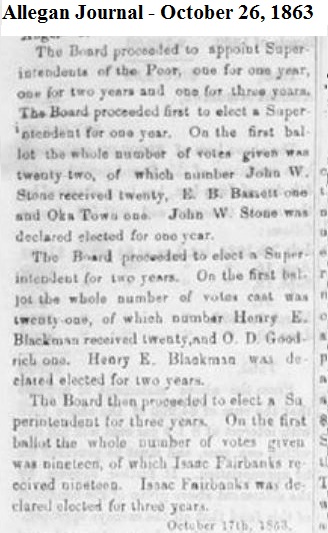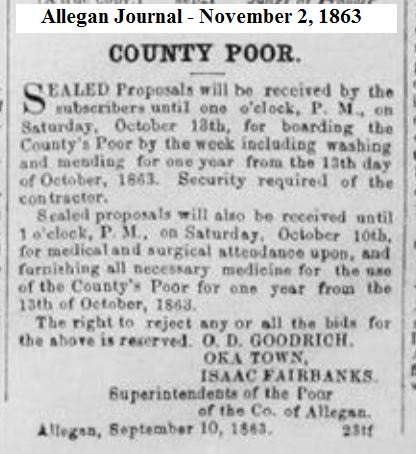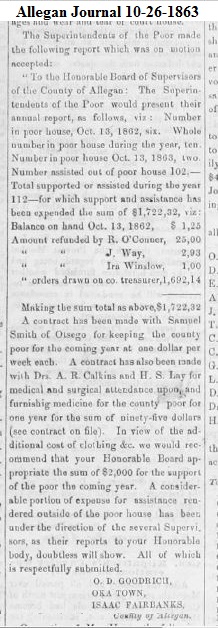The following is from
History of Allegan County, Michigan,
By Dr. Henry F. Thomas - 1907
Chapter 1 - Provisions For The Poor - page 14

Prior to the Allegan County poor house, Superintendents of the Poor were elected for one, two and three years by the Board.
1864 Nominations
are: John W. Stone for one year, Henry E. Blackman for two years, Isaac Fairbanks for three years. |

Prior to the Allegan County poor house, proposals for boarding the poor for a year were accepted. |

In 1862, there were ten in poor house and in 1863, there were two. 102 were assisted out of the poor house.
Samuel Smith of Otsego was on a contract to keep the county poor at $1/week each for the coming year. |
At the first township meeting, April 6, 1833, when Allegan township comprised the entire county, Giles Scott
and H.C. White were elected overseers of the poor. Such officers were elected at each township meeting until
county organization. Doubtless their office was a sinecure, being both without duty and without pay. But
even when the county was young and its inhabitants were few, there were some poor among them, and some
public provision had to be made for their care. The board of supervisors in 1837 constituted a poor fund of
one hundred dollars, this being the first definite provision for the destitute, and in the following year a
a pauper was supported nearly a month at the public charge. Until 1839 each township cared for its own poor,
but in that year it was voted to make paupers a county charge.
No systematic method of caring for the
poor was adopted until 1849. Previous to that time, the paupers being few, the need of a regular institution
for their care was not seriously felt. In that year a proposition was made before the board that a farm be
purchased at an expense not greater than twelve hundred dollars. No action was taken, and the matter remained
in an unsettled state for a number of years, the superintendents of the poor meanwhile making such provisions
as they were able by obtaining temporary quarters for those in their charge.
Finally a committee was
appointed to examine farms suitable for the purpose, and its report, made January 14, 1866, recommended the
purchase of the quarter section owned by J.P. Pope, in the southeast quarter of section 5, Allegan township.
In accordance with the report, the farm was purchased for $7,000, the deed being recorded June 15, 1866. This
has since been the site of the poorhouse and institutions.
|


 Return To Home Page
Return To Home Page

 Return To Home Page
Return To Home Page
